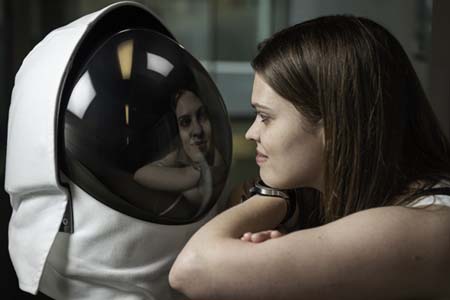Mars makings
Geology student researches makeup of the red planet
By Katie Messerla
 Sarah Lamm is passionate about Mars, science communication and student outreach.
Sarah Lamm is passionate about Mars, science communication and student outreach.
For the last three years, Sarah Lamm, master’s student in geology in the Kansas State University College of Arts and Sciences, has spoken to audiences totaling more than 2,000 about the Curiosity rover, a car-sized rover currently exploring the Gale Crater on Mars as part of NASA’s Mars Science Laboratory mission.
Lamm was on the Curiosity rover team for three years, which gave her unique insight into the operations and science behind the Mars rovers — Curiosity in particular. She now shares her experience with youth at every opportunity. While she has spoken in New Mexico and Arizona, about 70% of her presentations have been in rural Kansas.
“It is important to show students new career paths simply because they can’t be what they can’t see,” Lamm said.
Lamm’s extensive outreach led to her selection as a NASA Solar System Ambassador in 2018. Since then, she has held more than 50 successful events at museums, science clubs, local clubs and schools.
“I’m very passionate about outreach and I’m always looking for ways to make my outreach more effective,” Lamm said.
Lamm was selected as a 2019 Mars Generation 24 Under 24 Leader and Innovator in STEAM and Space for her work in rural Kansas. Additionally, in November 2020, Lamm received a Science Communication Award from the Kansas Science Communication Initiative, which helps K-State faculty, students and staff engage the public in science and research.
Her master’s research at K-State focuses on creating a Raman calibration to determine chlorite chemical composition. She works under adviser Brice Lacroix, assistant professor of geology.
Chlorite is a clay mineral group made of different layers of elements that can change. One layer might be silicon or aluminum, or a mixture of the two, while another layer might be aluminum, iron or magnesium, or a mixture of the three. Lamm uses Raman spectroscopy to analyze the chemical data of these chlorite minerals from an electron microprobe.
“In Raman spectroscopy, we shoot a laser at a substance and the substance will briefly absorb the energy from the laser, then transmit it back out,” Lamm said.
The frequencies transmitted are dependent on the mineral structure and the elements of the mineral. Lamm studies the tiny frequency changes and correlates them to changes in elemental composition. Chlorite’s chemical composition is based on the temperature at which it is formed. If a Raman laser is used to determine chlorite’s chemical composition, that data can be used to determine the temperature of the mineral’s formation.
Lamm’s research will help planetary scientists determine the chemical composition of chlorite on Mars, which will give more insight into the past Martian environment.
Lamm will graduate with her master’s degree by August and is planning to continue in a doctoral program.